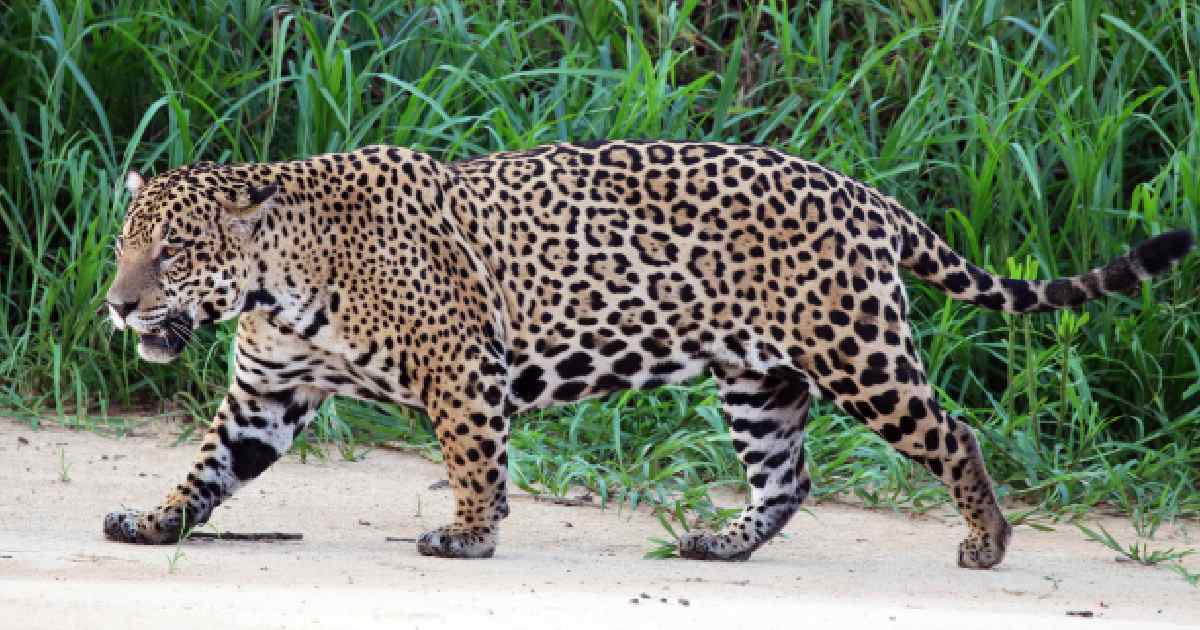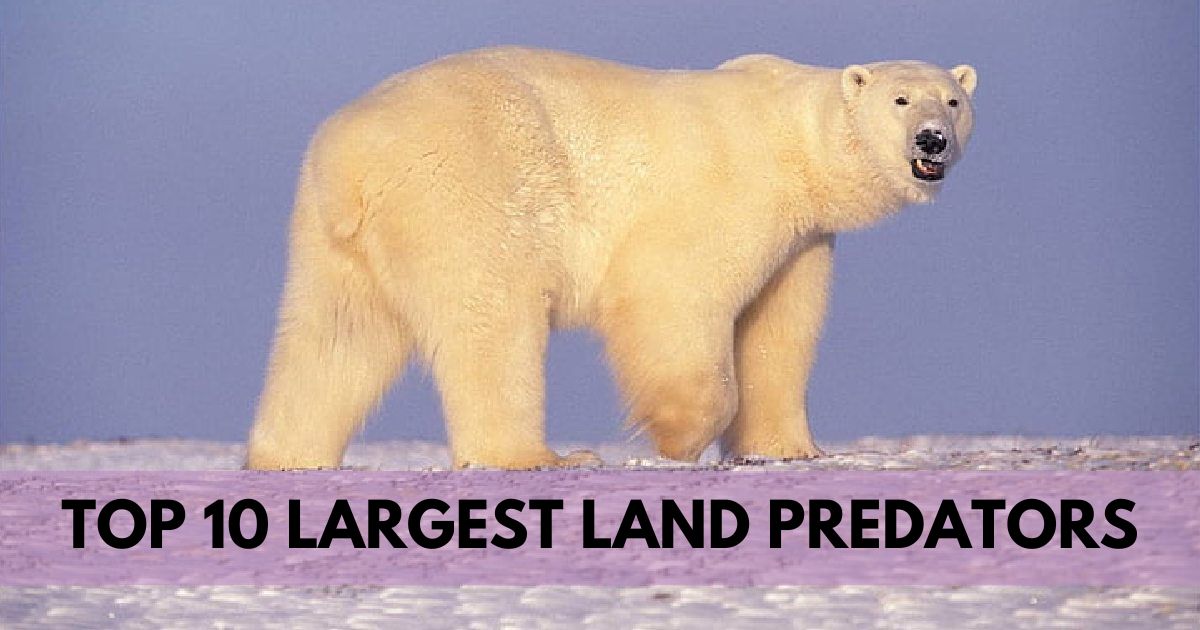Predators at the top of the food chain hold a unique place in the natural world. These largest land predators play crucial roles in maintaining the balance of ecosystems, regulating prey populations, and even influencing vegetation through their hunting habits. The blue whale, which is the largest carnivorous creature, inhabits the water, but the majority of huge carnivorous creatures are found on land.
In this article, we’ll explore some of the most formidable land animals, delving into their habitats, physical characteristics, and remarkable hunting skills. We’ll journey across continents, meeting powerful bears, stealthy big cats, and the iconic lion, all of whom reign supreme in their domains.
10. Giant Panda

- Average Mass: 113 kg
- Native Range: Asia
- Key Features:
- Diet: Primarily bamboo
- Distinctive black and white coat
- Strong jaws for crushing bamboo
Despite their cuddly appearance and predominantly vegetarian diet, giant pandas are indeed part of the bear species and thus classified as carnivores. Native to China, these black-and-white bears now reside only in small, isolated patches of bamboo forests in the southwest of the country. They were once widespread across much of southern and eastern China.
Giant pandas have a unique digestive system more suited to a carnivorous diet, which is why they must consume large quantities of bamboo – up to 38 kilograms daily – to meet their nutritional needs. Occasionally, they will hunt small rodents, but their primary food source remains bamboo. Conservation efforts have recently helped stabilize their numbers, but they remain one of the world’s most vulnerable bear species.
9. Jaguar

- Average Mass: 113 kg
- Native Range: North America, South America
- Key Features:
- Powerful bite, capable of piercing skulls
- Excellent swimmer
- Spotted coat for camouflage
The jaguar is the largest cat in the Americas, renowned for its powerful build and formidable hunting skills. Jaguars predominantly inhabit the dense rainforests of the Amazon, but their range extends to swamps and woodlands throughout Central and South America. These solitary hunters excel in stalking and ambushing their prey.
Jaguars have a broad diet that includes capybaras, peccaries, deer, birds, and even caimans and fish. Their strength allows them to crush the skulls of their prey with a single bite, a feat unmatched by any other big cat. Jaguars are also proficient swimmers, often hunting in water, which sets them apart from many other felines.
8. Sloth Bear

- Average Mass: 136 kg
- Native Range: South Asia
- Key Features:
- Specialized lips for sucking insects
- Shaggy, unkempt fur
- Noisy eaters
Sloth bears are a unique bear species native to the Indian subcontinent, including Sri Lanka, Bangladesh, Nepal, and Bhutan. These bears prefer lowland forests and grasslands, often seeking out rocky outcrops where they can find insects like termites and ants.
Unlike other bears, sloth bears have evolved to consume a diet rich in insects. Their long, curved claws and specially adapted lips make them highly efficient at extracting termites from their mounds. Sloth bears also eat fruits, honeycombs, and occasionally small mammals. Despite their relatively small size compared to other bears, they are known for their aggressive nature, particularly when protecting their young.
7. Spectacled Bear

- Average Mass: 136 kg
- Native Range: South America
- Key Features:
- Distinctive facial markings
- Excellent climbers
- Omnivorous diet
The spectacled bear, also known as the Andean bear, is the only bear species native to South America. They inhabit the cloud forests and highland moors of the Andes, ranging from Venezuela to northern Argentina. These bears are named for the unique markings around their eyes, which give the appearance of spectacles.
Spectacled bears are highly arboreal, spending a significant amount of time in trees. Their diet is diverse, including fruits, berries, small mammals, insects, and birds. They are excellent climbers, using their strong forelimbs to navigate the forest canopy in search of food. Despite their omnivorous habits, spectacled bears are classified as vulnerable due to habitat loss and hunting.
6. Asiatic Black Bear

- Average Mass: 136 kg
- Native Range: Asia
- Key Features:
- White chest marking
- Versatile diet
- Lives in mountainous regions
Asiatic black bears, also known as moon bears, are found across a broad swath of East Asia, including the mountainous regions of Afghanistan, Pakistan, India, Nepal, China, and parts of Russia and Taiwan. These bears are easily identified by the distinctive white “V” or crescent-shaped mark on their chests.
These bears have a varied diet that includes fruits, nuts, insects, small mammals, and carrion. They are known to raid crops and livestock, leading to conflicts with humans. Asiatic black bears are adept climbers and often den in trees. Despite their adaptability, their populations are threatened by habitat destruction and illegal hunting for their body parts used in traditional medicine.
5. American Black Bear

- Average Mass: 159 kg
- Native Range: North America
- Key Features:
- Variable fur color
- Highly adaptable
- Omnivorous diet
American black bears are the most widespread bear species in North America, found in forests, swamps, and even suburban areas from Canada to Mexico. Despite their name, these bears can be black, brown, or even white (the Kermode bear or “spirit bear”).
Black bears have an omnivorous diet that changes with the seasons. In spring, they may prey on young moose and deer, while in summer and fall, their diet shifts to berries, nuts, and insects. They are known for their intelligence and problem-solving skills, often figuring out ways to access human food sources. This adaptability has allowed them to thrive despite human encroachment on their habitats.
4. African Lion

- Average Mass: 200 kg
- Native Range: Africa, Asia
- Key Features:
- Social structure in prides
- Distinctive mane in males
- Powerful roar
The African lion, often dubbed the “king of the jungle,” is a symbol of strength and courage. These majestic predators once roamed across much of Africa, but today they are primarily found in central and southern regions. Lions live in prides, social groups consisting of related females, their offspring, and a few adult males.
Lions are unique among big cats for their cooperative hunting strategies. Female lions, the primary hunters, work together to take down large prey such as zebras, wildebeests, and buffalo. Males play a crucial role in protecting the pride and securing territory. Lions’ impressive roars can be heard up to 8 kilometers away, serving as a communication tool and a means of establishing dominance.
3. Bengal Tiger

- Average Mass: 227 kg
- Native Range: Asia
- Key Features:
- Striking orange coat with black stripes
- Solitary hunters
- Powerful swimmers
Bengal tigers are the largest members of the cat family and among the most iconic predators in the world. These magnificent creatures are primarily found in India, with smaller populations in Bangladesh, Nepal, Bhutan, and Myanmar. Bengal tigers inhabit a variety of landscapes, from dense rainforests to mangrove swamps and tall grasslands.
Tigers are solitary hunters, relying on stealth and power to ambush their prey, which includes deer, wild boar, and water buffalo. Their distinctive stripes provide camouflage in the dappled sunlight of their forested habitats. Despite their fearsome reputation, Bengal tigers are endangered due to habitat loss, poaching, and human-wildlife conflict. Conservation efforts are crucial to their survival.
2. Brown Bear

- Average Mass: 318 kg
- Native Range: North America, Europe, Asia
- Key Features:
- Varied diet
- Strong and agile
- Can stand on hind legs
Brown bears, including grizzly bears and Kodiak bears, are among the largest land carnivores. These impressive animals are found across Europe, Asia, and North America, with significant populations in Russia, Canada, and Alaska. Brown bears have a diverse diet, ranging from berries and plant roots to fish and small mammals.
Grizzly bears and Kodiak bears, subspecies of the brown bear, are known for their incredible strength and agility. They can stand on their hind legs to survey their surroundings and use their powerful limbs to dig for roots or catch fish. Brown bears play a critical role in their ecosystems, helping to control prey populations and disperse seeds through their scat.
1. Polar Bear

- Average Mass: 360 kg
- Native Range: North America, Eurasia
- Key Features:
- Largest land carnivore
- Thick fur and blubber for insulation
- Excellent swimmers
- Dependence on sea ice
Polar bears are the largest land carnivores on the planet, and they have a maximum length of 310 cm, which is perfectly adapted to their harsh Arctic environment. These majestic predators are found across the polar regions of North America, including Alaska, Canada, Greenland, and parts of Russia and Norway. Polar bears primarily hunt seals, relying on the sea ice as a platform to catch their prey.
With their thick fur and layer of blubber, polar bears are well-insulated against the frigid temperatures of the Arctic. They are also strong swimmers, capable of covering vast distances in search of food. However, climate change poses a significant threat to polar bears, as melting sea ice reduces their hunting grounds and access to prey. Conservation efforts are crucial to protect these iconic animals and their habitats.
Conclusion
The largest land predators are remarkable creatures, each uniquely adapted to their environments and playing vital roles in their ecosystems. From the polar bear’s icy realm to the dense forests of the jaguar and the savannahs of the African lion, these predators demonstrate the incredible diversity and complexity of the natural world. Understanding and protecting these magnificent animals is essential for maintaining the balance of nature and ensuring their survival for future generations.
Frequently Asked Questions (FAQs)
What is the largest land predator on Earth?
The largest land predator on Earth is the polar bear. These majestic creatures, found in the Arctic regions of North America, Eurasia, and Greenland, can weigh up to 360 kg (around 800 pounds) on average. Polar bears primarily hunt seals, relying on sea ice as a platform to catch their prey. Their thick fur and blubber layers insulate them against the extreme cold, making them perfectly adapted to their harsh environment.
What is the most powerful predator on land?
The most powerful predator on land is arguably the Bengal tiger. Known for their strength and stealth, Bengal tigers are the largest members of the cat family, weighing up to 227 kg (500 pounds). Found in India and parts of Southeast Asia, they can take down large prey such as deer, wild boar, and water buffalo. Their powerful limbs, sharp claws, and strong jaws make them formidable hunters.
What is the biggest earth predator?
The biggest earth predator by mass is the polar bear, with adult males averaging around 360 kg (800 pounds). These apex predators inhabit the Arctic regions and are well-adapted to cold environments. They primarily hunt seals, using their powerful limbs and sharp claws to break through ice and capture their prey. Polar bears’ dependence on sea ice for hunting makes them vulnerable to climate change.
What is the deadliest land predator?
The deadliest land predator is the African lion, renowned for its power and teamwork. Lions, especially those in pride, are incredibly effective hunters, capable of taking down large prey such as zebras, wildebeests, and buffalo. Weighing around 200 kg (440 pounds), these apex predators use coordinated hunting strategies and their powerful jaws and claws to bring down their prey.
Who is the apex predator of the land?
The apex predator of the land varies by region, but globally, the polar bear is considered one of the top contenders. These formidable hunters, native to the Arctic, dominate their harsh environment with no natural predators. Weighing up to 360 kg (800 pounds), polar bears primarily prey on seals, relying on sea ice for hunting. Their position at the top of the food chain is threatened only by climate change.

